#retro dash
Text

#pokemon#nintendo#anime#gaming#video games#funny#lol#humor#meme#drake#hoppip#drones#ai#tech#technology#door dash#uber eats#anipoke#pokeani#retro#gameboy#retrogaming
2K notes
·
View notes
Photo
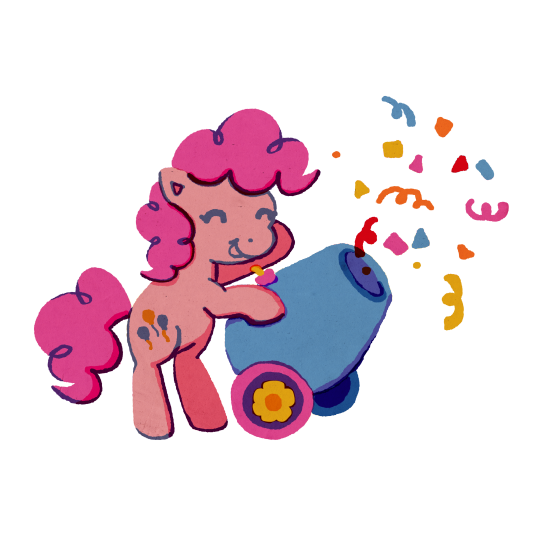



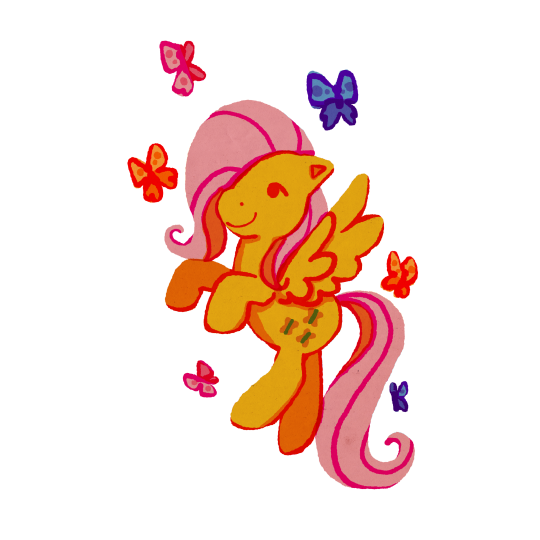
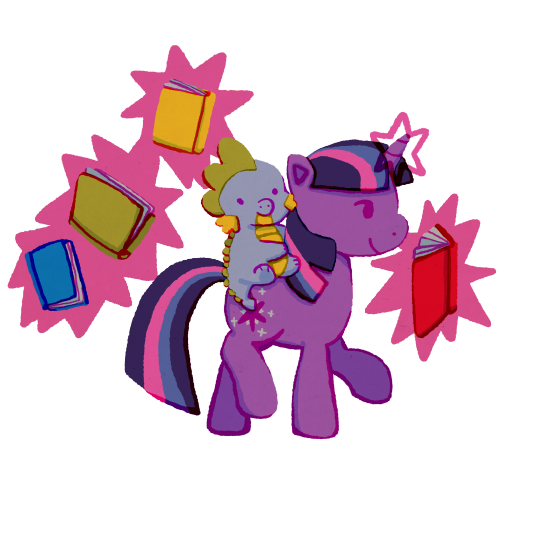
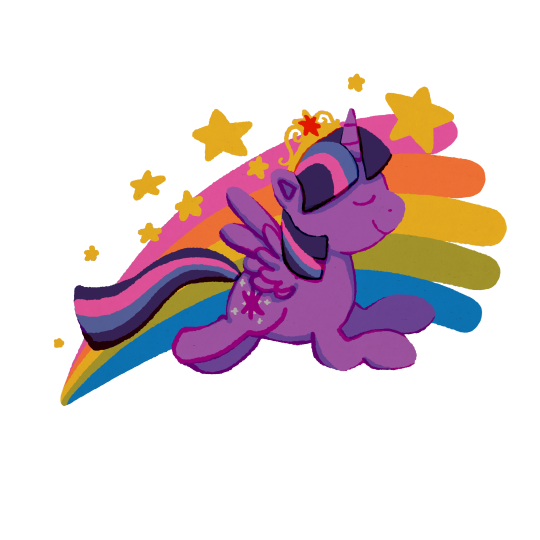
I have a Redbubble now!!! I plan on adding more but I’m pretty proud of this collection I just finished, inspired by vintage stickers à la Sandylion :3
#mlp#mlp fim#My Little Pony#mane six#friendship is magic#Twilight Sparkle#pinkie pie#applejack#rainbow dash#rarity#fluttershy#spike the dragon#stickers#retro#sandylion#nostalgia#vintage aesthetic#mlp g4#brony#kidcore#redbubble#ponies#cute
6K notes
·
View notes
Text

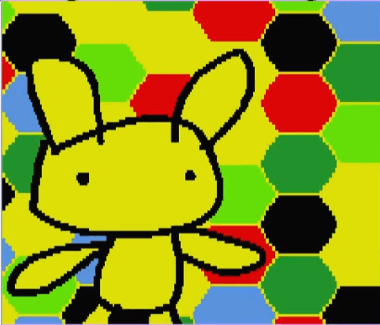
#logical dash#beatmania#gif#flashing gif#flash warning#eyestrain#konami#retro gaming#mine: gif#y2k design#bemani
167 notes
·
View notes
Text

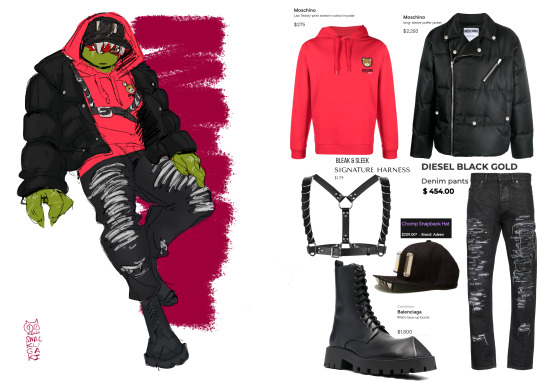
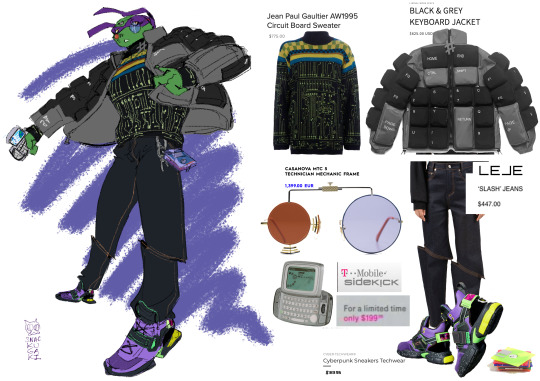

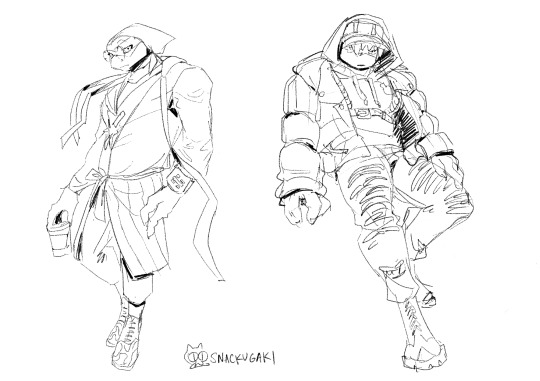

surprise my other hobbies are window shopping and fashion
#something something having hobbies across fields genres media and subjects can only enrich and influence your artmaking#because Mikey strikes me as a maximalist#Donnie gives me vintage and statement pieces feelings#Leo... minimalist with a sprinkling of avant silhouettes and a dash of retro#Raph... just wears what April suggests with the barest idea of what he likes#wherein my iteration April is deep in the goth an punk scene so she gotta drag this turtle man through her closet#legoclacking my usual linework with fashion illustration was a fkkn trip#god there's a look from Balmain RTW AW 2016 i wanna put my Leo in.....#fuck it I will who's gonna stop me?#balmain?#i'm so curious what the kids will tag this as#i say tagging everything but what this is#snack iteration?#my iteration?#i know the red blue glasses is gonna get one of these kids tagging it as rise#others gonna clock their li'l dumpling heads and tag as 03#what they don't know is my iteration is mainly based off Archie run comics and Next Mutation#mehehehehehehehehe#...hiiiiiiiii kiiiiiiiiiing#OuO#accessories was tough because I like it costume and avant#so it was a miracle finding a “normal” bracelet#and a bigger miracle it happened to feature the water trigram#mwah mwah beautiful coincidence#weekend negates demon hours stop snitching
185 notes
·
View notes
Text
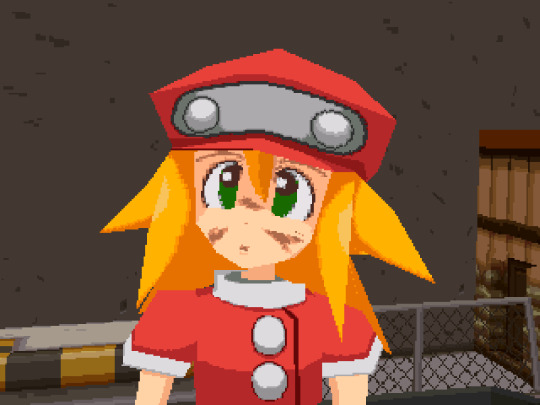
Megaman Legends
Playstation
1997
#acquired stardust#screenshots#larsa#capcom#megaman#megaman legends#mega man#mega man legends#roll#roll caskett#playstation#PSX#psone#low poly#retro games#retro gaming#rockman dash
197 notes
·
View notes
Text

#Power Dolls 2 Dash#KogadoStudio#pc98#Kogado Studio#PC-98#pixel art#pixel desig#mecha#mech#retro gaming#pc gaming#scifi#character design#1990s#90s#art#design#style
95 notes
·
View notes
Text
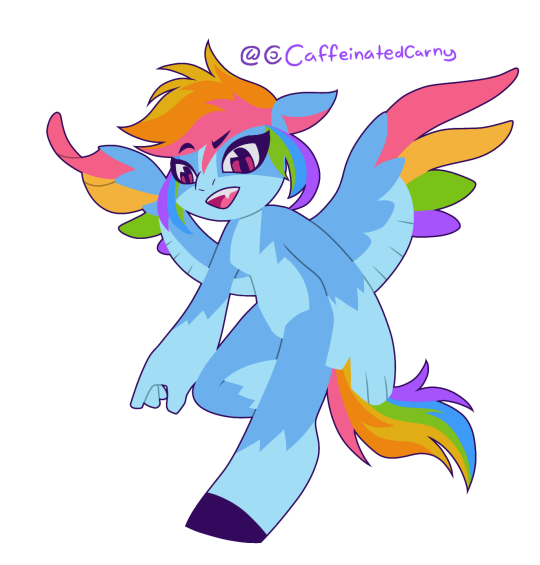



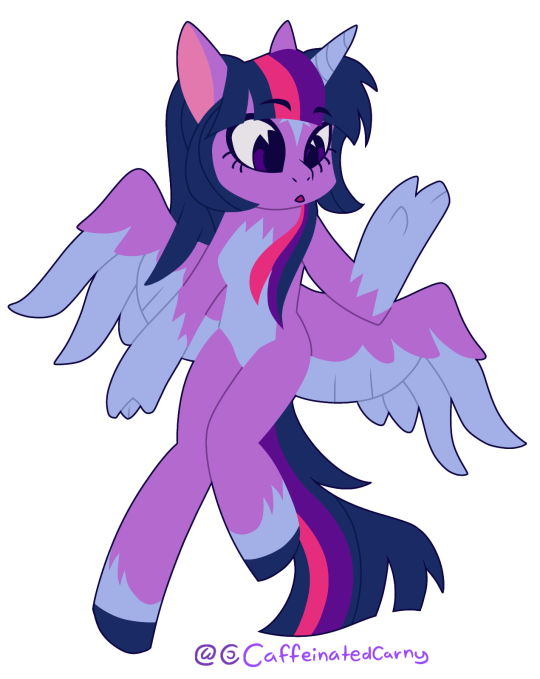
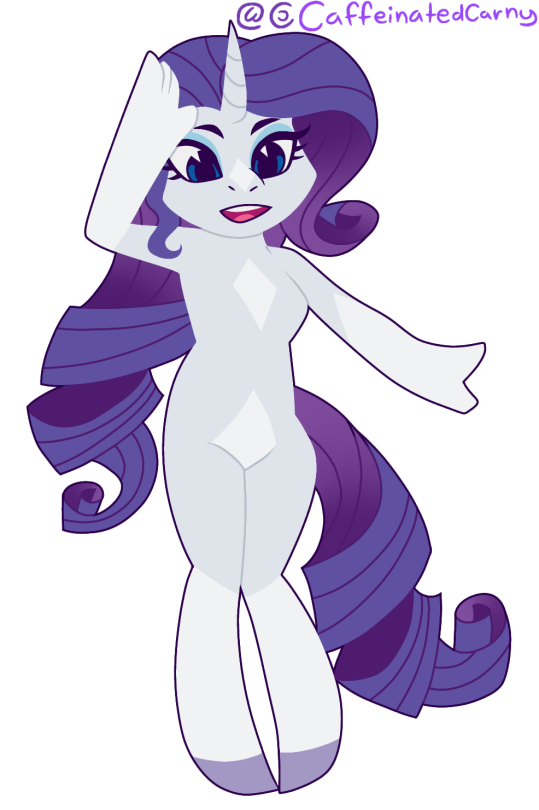
A cute and silly idea ive been working on recently! A nostalgic style of the main 6 ^^ Please do not use or repost without my explicit consent<3
#art#carny art#mlp#digital art#my little pony#rainbow dash#pinkie pie#fluttershy#applejack#twilight sparkle#rarity#main 6#nostalgia#retro
88 notes
·
View notes
Text

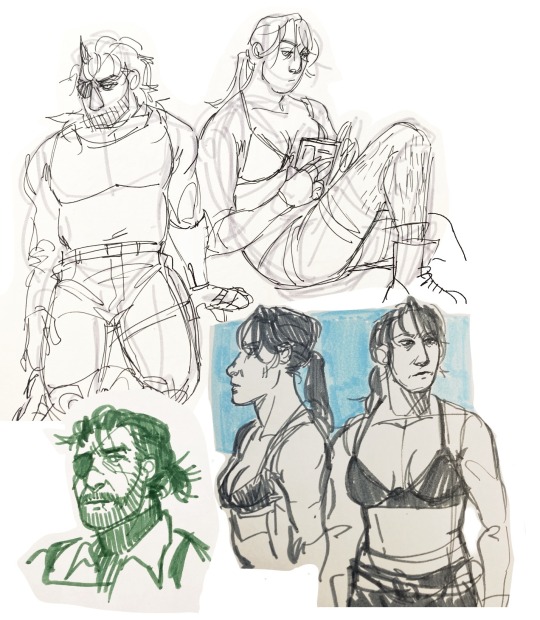
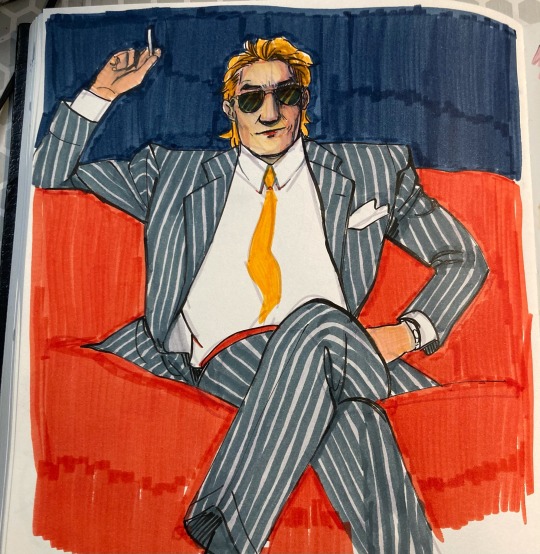
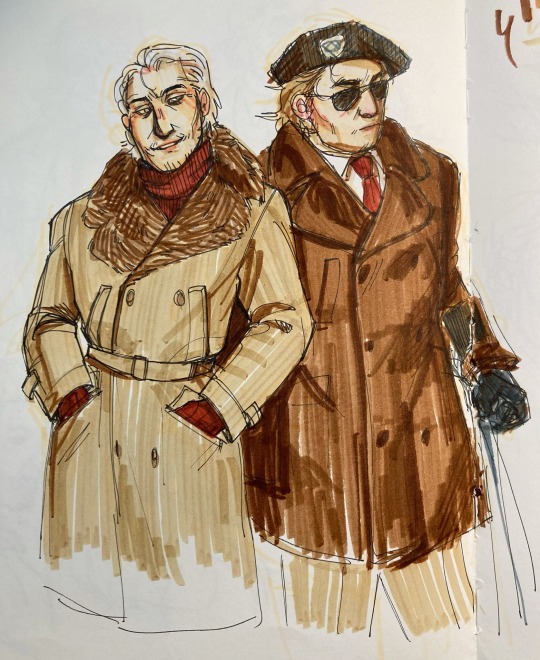
Really churning thru this sketchbook... markers are so fun
#mgs#ocelot#kazuhira miller#eva#venom snake#sniper quiet#i know if kaz and eva ever met it would be a disastr#she'd eat him alive. but consider the 2018 hit singles retro future and 365 fresh by acclaimed kpop group triple h#and put them in that situation. you understand.#id in alt text#god can they not make it easier to add alt text instead of whatever the fuck they're doing to the dash for no reason. help
104 notes
·
View notes
Text
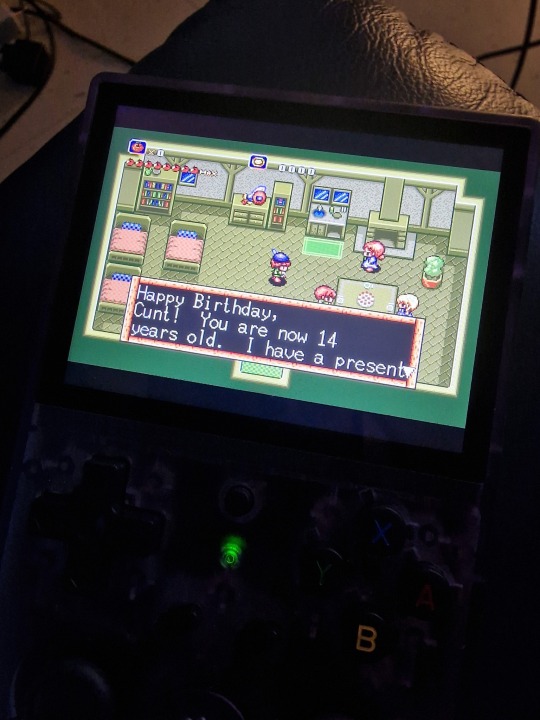
I miss the days when you could name your character anything you wanted...
#game#gaming#retro#retro gaming#video games#games#tag game#dash games#retrogaming#all for the game#retro moodboard#retro tech#retro aesthetic#retrowave#retro gaming times#retro futuristic#retro collection#rpg#retromedia#retro style#retrospective#gameboy
125 notes
·
View notes
Text
°:⋆ ☁️🦄✨My little pony characters in DecoraKei Style!🌈🧁⭐️✩⡱






follow me in twitter and instagram: @lilpinkghost
#my little brony#pinkie pie#rainbow dash#fluttershy#applejack#rarity#twilight sparkle#mlp fim#mlpfanart#mlp g4#artwork#kidcore#kidcore art#rainbowcore#decora kei#decora style#decora fashion#retro style#stickers#softcore#colorful#fanart#lilpinkghost
280 notes
·
View notes
Text
How to get into Hokuto no Ken, A Guide
Hokuto no Ken, localized as Fist of the North Star, is the wildly popular and influential series penned by Buronson and drawn by Hara starting in 1983. It is a timeless tragedy about the power of love that taps into imagery from both Catholicism and Buddhism, while also being an homage to a variety of western 80's pop culture from Mad Max to Blade Runner to Rocky.
In the current anime fanscape, HnK is perhaps best known for being one of the key influences behind Jojo's Bizarre Adventure and Berserk, however it should be known that the series' influence permeates the entire Shonen genre. Traces of the tropes and dynamics that it popularized can be seen throughout Shonen today, from Naruto's drive for love and friendship that contrasts with Sasuke's rejection of the idea and desire to sever any bonds of love, to the implementation of Haki in One Piece.

So with all that in mind, let's get into the specifics.
The place to start with this franchise is very straightforward: read the original manga or watch the anime adaptation. There are a number of movies that retell parts of the original story, but they all have different downsides and cut important aspects of the source material and thus are a bad place to start.
This primary canon is broken down into two (three) parts, as follows:
HnK or "HnK1" is the core of the series, starting at the Shin arc through the originally intended ending at chapter 136/episode 108. Most of the time if someone is referring to HnK, this is what they are talking about.
The beginning of the series is a bit of a slow start, bouncing between villains of the week before actually kicking off the primary conflict (especially in the anime, more on this later). This is somewhat typical for the era-- these early arcs were written while the authors had no idea if they were going to get dropped from Shonen Jump. For this reason, I highly recommend sticking with the series until the Fang Clan Chieftain and Jagi arcs even if the beginning hasn't clicked with you yet.
HnK2 is the continuation of the series, where the authors were pressured to continue working on the series because of the money it was raking in. This naming convention comes from the title of the anime for this portion of the story, chapters 136-210/episodes 110-152.
Quite frankly, the fact that this is past the originally intended ending is very evident; Buronson has been quoted as never re-reading it after publication.[1] It's very much worth checking out at least once if you enjoyed HnK1-- there are absolutely memorable characters and fights, as well as some of the best art in the series-- but be prepared for a general drop in writing quality.
"Post-Kaioh HnK" or "HnK3" is the last leg of the original manga, which has never been adapted elsewhere. Chapters 211-245.
Content Warnings
Explicit Sexual Assault
The elephant in the room when discussing this series is that some social aspects of it are very of-the-era. There are two instances of explicit sexual assault, which get dismissed as "well the perpetrator didn't have the best execution, but he did have the right idea..." The pages/timestamps to avoid this are:
Manga volume 02 pages 287-289; volume 03, pages 063-066 (Ultimate Edition numbering)
Anime episode 24, 13:04-13:53; episode 26 08:29-09:22
Mild Gore
I almost feel like it goes without saying, but this is famously the series where the protagonist makes baddies heads explode. While this is never depicted in graphic detail, HnK as a whole is going to be a bad fit if this distresses you in any way.
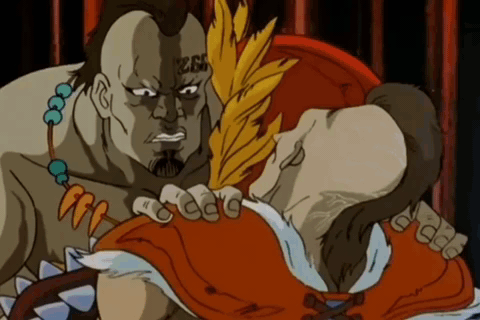
An early example of the aforementioned head asplosions.
Photosensitivity
The anime makes period-typical use of flashing lights in nearly every episode. If you are photosensitive (and can't take measures to mitigate the flashing), you should read the manga instead.
If you want to read the manga...
The manga is the way that I personally recommend getting into the series due to Hara's absolutely gorgeous art.

The manga is also generally seen as the true 'canon'; For example, colorschemes used in subsequent works typically draw from colored chapter/volume covers rather than the Toei anime. For this reason, this version of the series is what the Japanese audience usually thinks of when they think of HnK.


I know some people are very passionate about redhead Mamiya and crest toothpaste-head Rei, but the Toei colors functionally exist in their own separate continuity.
Reading the manga in English is far better now than it was even three years ago, as there are multiple English versions now available.
The official VIZ release is the defacto highest quality out there (support the print copies if you can). While there are a few odd translation choices and the SFX have been replaced with English ones, it has the highest fidelity copies of the original art and even has the original color pages that have not been published since the original Shonen Jump release.
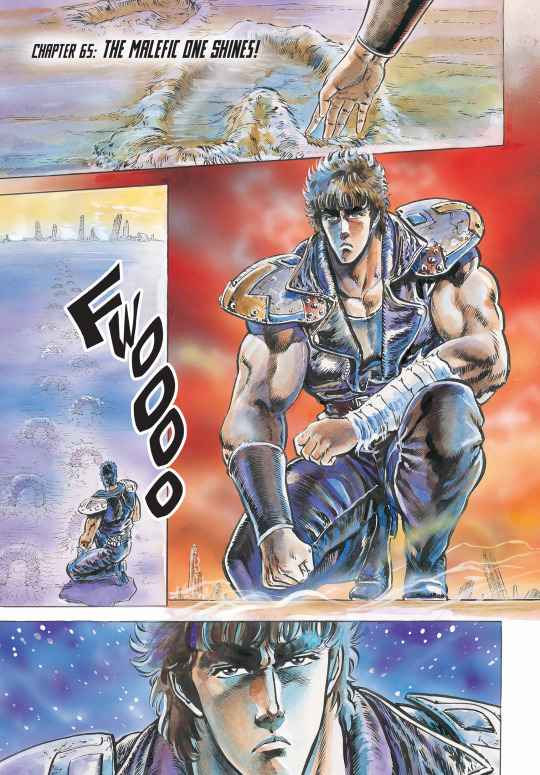
To think that these wonderful colored pages were completely inaccessible, even to JP audiences, until Viz started rolling out the English volumes.
However, the Viz release is ongoing and only covers until volume 11 at the time of writing. If you want to read the rest of HnK2 (or highly value the original SFX and a smoother translation), you should seek out the official eOneBook release. This is sometimes labelled as "Digital - 2018" and is a rip of an official English translation that was released for a specialized eReader, copies of which been floating around online since about 2020.
There is also an older set of scanlations out there, which I would not recommend reading; The image quality is low-resolution and muddy, and there are a number of edgy translation choices such as inserting a homophobic slur that was not in the original text. I only mention this translation because it's the one on many online manga sites. Please love yourself and look elsewhere if you realize that you are reading these scans.

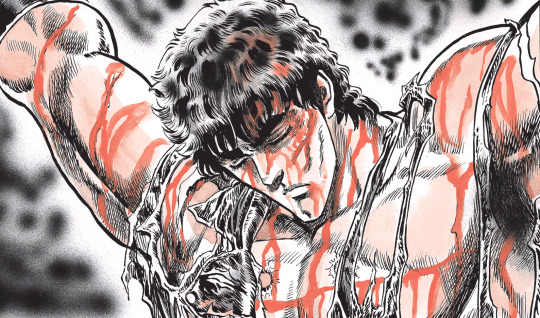


(left) English-language scanlations (right) Viz release from 2022. I distinctly remember first reading these pages and then immediately scouring the web to find a version of it that didn't have the contrast blown out, only to discover that this quality was all that available. Now, newcomers to the series don't have to worry about this at all.
There are two different versions of the complete manga, the original tankobons (27 total volumes) and the Ultimate Edition (17 volumes).[2] Both the Viz release and the eOnebook release are derived from the Ultimate Editions while the old scanlations are from the original tankobons, so this can be an easy way to identify which version you are reading.
As to what makes these versions different aside from chapters per volume, the Ultimate Editions clean up some of the art in the last few volumes and also includes "Last Piece", a one-shot by Buronson and Hara inserted between HnK1 and HnK2. This was written as a part of the 30th anniversary celebration, and Hara's art looks quite different 30 years down the road, making the abrupt change in style rather jarring-- consider this your heads-up.
TL;DR Read the Viz version for volumes 1-11, and the eOnebook rips for the rest.
If you want to watch the anime...
The 1984 anime adaptation of HnK is an all-time classic. It's often what western fans will think of first, between the manga being legally inaccessible in English until very recently and constant anime reruns in some markets (especially parts of Italy and France).
youtube
Toei has a tendency to copyright-strike anime clips on Youtube, so hopefully this clip of the opening will stand the test of time.
The anime genuinely excels in a few departments, namely: music, sound design, and voice acting. Even if you don't decide to watch the anime, I highly recommend looking up the OPs/EDs and putting on the OST while reading the manga.
That said, there are definitely some downsides to the anime, a lot of which were typical for Toei animations of the era. Character models and direction are all over the place, some of the animation itself aged like milk, flashing light effects make the series difficult to get through for photosensitive viewers, and stock footage gets reused many times. There also isn't a complete English dub of the show, as it got cancelled after episode 36.
And the biggest caveat to the anime: Filler episodes. Oooooh boy, early HnK filler episodes are baaaad. They don't match the rest of the series tonally and completely botch any sense of pacing. Remember how earlier I said that the series takes a while to get its footing because of early bad-guy-of-the-week format? The anime drags this out for about twice as long by adding new bad guys of the week.
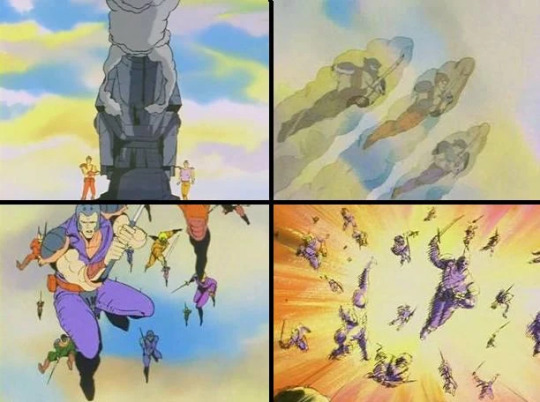
The infamous "Nanto Cannonball Fist", where users are launched from a cannon and descend on their opponents with a sword. Yeah, I don't know how this counts as a school of martial arts, either. [img source]
For a first watch through, I highly recommend following a filler episode guide to skip these episodes in the Shin arc and get a better feel for what the series is about. Post Shin-arc filler tends to be a lot better, as these episodes match the manga's original tone and often fix pacing problems in the source material rather than worsening them.
That said, there are a few early filler episodes that are well-liked by fans for one reason or another, which I will detail here.
Episode 17: A (non-canonical) view into the internal politics of Shin's army.
Episode 18: In which Kenshiro fights a tank.
Episode 19: The goofiest of the goofy filler episodes. If you want to watch one filler episode to get a sense of what they are like, watch this one.[3]
Episode 21: A continuation of some of the conflicts from episode 17.
Episode 38: Features one of the best-written woman martial artists you'll see in this franchise. (This is after Shin arc, but I had to point her out. Watch this one.)
Rage Quitter 87's fansite also has an excellent episode-by-episode guide covering anime and manga differences, which can be very useful for highlighting some of the more subtle differences between the two.
An anime remake that more closely follows the manga has been announced, but we have no further details on it at the time of writing. (I wouldn't hold my breath for this, it could be several years before we know more.)
TL;DR skip the episodes listed here under "Shin arc".
So I got through the main canon, what next?
The sheer amount of secondary content for HnK out there can be overwhelming. It's one of the most profitable IPs of all time, with the bulk of those profits coming from pachinko machines that will never make it to the west outside Youtube phone clips and asset-flip games (more on this later). When the series isn't being used to sell soap, there are a number of supplemental works that are absolutely worth checking out. In this guide I will focus on works that are currently available in English.
The Official Gaidens


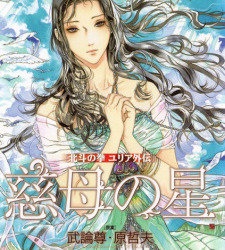

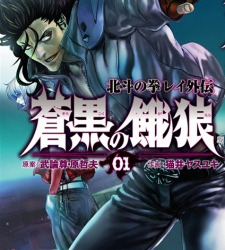
A series of manga with different protagonists and created with different creative teams, the Hokuto side-stories fill in some of the gaps in the primary canon. Most of them are very loving additions to the continuity and are a good place to go after finishing the primary material.
Toki Gaiden: Silvery Savior follows Toki starting from the founding of the Village of Miracles and ends after his climactic final fight, providing his lens on the events of the series and his relationship with Raoh. This gaiden does a good job of understanding what fans like about the series, and has a lot of secondary character interactions that were missing in the original work such as conversations between different Ken-oh underlings.
Jagi Gaiden: Flower of Carnage follows Jagi through his childhood, interspersed with the events of canon. This gaiden does a lot to explain why Jagi ended up the way he did, provides additional context to what the Hokuto children's training looked like, and how the world changed when the apocalypse happened. cw: rape
Yuria Gaiden: The Affectionate Mother Star follows Yuria before the apocalypse happens, giving us a snapshot of domesticity with Kenshiro, a better understanding of her abilities, and illustrating how her life was always influenced by those who had fallen for her.
Juza Gaiden: The Wandering Clouds follows Juza as meanders around canonical events, giving insight into what he was like as he shifted from wandering without drive or purpose to becoming a sworn guardian to the Last Nanto General.
Rei Gaiden: Bloody Wolf's Darkness is one that I wish I could leave off of this list, but that I will include for completeness' sake. It follows Rei before his appearance in HnK as he goes through the exact same character arc that he has in canon. The city that he wanders into has a setup directly out of a porn plot, thoroughly justifying the manga's ecchi genre-tag. cw: sexual assault. repeatedly.
Souten no Ken and Souten no Ken: Regenesis


Souten no Ken, otherwise known as Fist of the Blue Sky, is a prequel series that follows Kenshiro Kasumi, 62nd successor to Hokuto Shinken and uncle to the Kenshiro from HnK, as he has martial arts adventures and tumbles with gangsters in 1930's Shanghai. The series revisits many of the character archetypes from HnK and plays around with the same plot points in different contexts, ultimately dealing with themes of friendship and fate.
Souten no Ken is a complete manga, drawn by Tetsuo Hara with plot supervised by Buronson. Souten no Ken: Regenesis is a direct sequel that is currently ongoing, drawn by Hideki Tsuji and written by Hiroyuki Yatsu. Regenesis has been on hiatus since 2020 due to Hideki Tsuji's ongoing health problems.
While there are animes with both of these names, here I am referring specifically to the manga-- neither anime is worth your time.
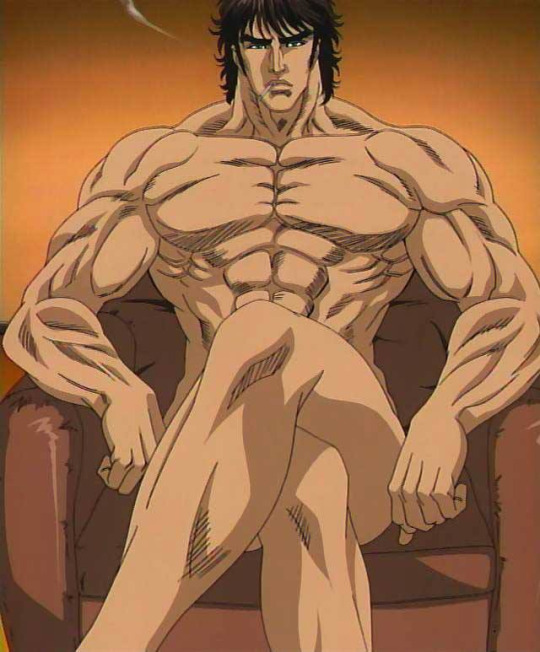

There. Now you've seen the only things that matter from both animes.
Fist of the North Star: Lost Paradise


Released in Japan as "Hokuto ga Gotoku" (Like a Big Dipper), Lost Paradise is an action-adventure game from the studio behind the Yakuza/Like a Dragon/Ryu ga Gotoku series. Fans of the RGG franchise will immediately recognize the game structure and mechanics, which balance advancing the main story thread with a semi-open world where the player can stumble into comedic sidestories and play assorted minigames.
youtube
Bartending is just one of the jobs that Kenshiro can take up in Lost Paradise.
The core story of the game features an entirely original cast, but most of the main characters of HnK show up for just long enough to have fights and cutscenes full of loving references to the source material. It's pure fanservice, in the non-horny sense of the word.
youtube
Team RGG really knows how to nail dynamic fight intros and epic QTEs.
Fist of the North Star: Ken's Rage and Ken's Rage 2
youtube
Even though some of the character design choices for this game are painfully mid-aughties (looking at you, tribal tattoo pattern Ken), this intro still goes hard.
For many years the Ken's Rage series were the definitive HnK games, and with good reason. A Musou game much like the Warriors series, you can play as most main characters from the series and mow down waves upon waves of bandits. Some may find the gameplay repetitive, but it can also be relaxing depending on how you look at it. (If you've played a Warriors game before, you know what you're getting into.)
Ken's Rage 2 in particular brings "Dream Mode" to the table, which is a "what if" story mode told from the POV of each playable character. This gives us a lot of interactions that we didn't get to see in canon (such as the delightfully shippy Jagi story featuring Amiba) and also expanding on some characters that should have gotten more screentime in the original material.
Hokuto no Ken (1986 animated movie)
youtube
It's the movie produced by (largely) the same team as the anime, created simultaneously to the show. If you want to know what the anime would look like if it wasn't trying to stretch every yen as thin as it could, this is your ticket.
That said, there are some odd choices made to carve a 110 minute long arc out of the early manga. The movie starts with Ken receiving his iconic scars, and ends with the first confrontation with Ken-oh.
DD HnK


This officially kicks off the "HnK comedy series" part of this list. I feel like comedy in particular can be subject to personal tastes, so keep in mind that each of these projects approaches the series from a different angle and that some may resonate better than others.
DD HnK is a comedic take on what the Hokutobros would get up to if the world didn't end. They end up working at a convenience store managed by Ryuken (voiced by Akira Kamiya, the original VA for Kenshiro), where hijinks ensue when other characters from the series show up.
It's worth noting that there are two animes and a manga with this name. The first anime is a Flash-based ONA (which is hard to find nowadays, for understandable reasons) and the second anime is the TV anime; Both of these series as well as the manga are very largely different. All series are complete, although the English fan translation for the manga is ongoing.
youtube
DD stands for "Design Deformation", evidently.
Ichigo Aji (Strawberry Flavor)
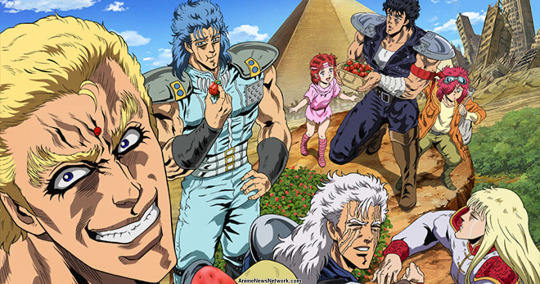
An average day with the Holy Emperor.
Ichigo Aji follows Souther on his quest to make some good friends. :) No really, that's more or less the premise of this spinoff.
While there are animated IA shorts at the end of every episode of DD HnK2, the meat and potatoes of this series are in the manga. The manga is ongoing (albeit on long-term hiatus) and the English fantranslation is currently incomplete (also on hiatus). Each volume of the manga also has a serious chapter following different characters from the series, serving as "mini gaidens" of sorts.
Genius Amiba's Other World Overlord Legend - Even If I Go to Another World, I Am a Genius!! Huh? Was I Mistaken...


In what originally started as an April Fool's Joke, the Amiba Isekai is perhaps one of the most unexpected additions to this franchise. The story begins after Amiba's death at Kenshiro's hands, where he finds himself transported to a fantasy realm where magic and creatures like dragons are real. He decides to use his self-proclaimed "genius" to learn magic in lieu of the martial arts that he studied earlier.
This manga series started in 2021 and is is still ongoing, although the English fantranslation is incomplete and has been on hiatus.
End of the Century's Drama Shooting Arc


The End of the Century's Drama Shooting Arc, more colloquially known as the Actor AU, is a retelling of the series as though it was a live-action TV show, covering the efforts and foibles of the actors and production crew as they struggle to produce the series.
The manga for this series started in 2021 alongside the Amiba Isekai and is ongoing, although the English fan translation is currently incomplete (Noticing a reoccurring trend here? a12 and Sakura Leaves, if you're out there, we really miss your work 🥹). If you can navigate the points system (new chapters are free within a few days of release) and use Google Lens, you can get a rough translation from the official Comics Zenon website.
The Winckler Dub
While not intentionally a comedy spinoff, I'm including the Winckler Dub in this section. There are apocryphal stories about this dub being produced as a means to teach Japanese schoolchildren basic English, interviews point to this dub being a sincere project to create a version of this series palatable to an English-speaking audience.
Please, just unmute this series of clips.
The only editing I did here was to append the files. They just. Speak with pauses like that.
With several downright bizarre directing decisions (Raoh is a pirate now, evidently?) and some of the strangest line-reads I've heard in an anime, this relic of an older localization industry can easily fall under "so bad it's good". Watch this with a group of friends after having a few drinks or late night at an anime convention, ideally.
The dub does not cover the whole series, instead bundling sets of 4 episodes into a series of 6 movie-length "sagas": Shin, Ray (sic), Souther, Toki, Raoh, and Kaioh.
Hokuto no Ken: Legends ReVIVE
I feel like it would be a bit disingenuous to finish this list without mentioning Legends ReVIVE, the current ongoing gacha for the franchise. (Worth noting: I am the admin for the unofficial discord server for this game, which is also the largest and most active English-speaking community for HnK.[4])

This game is possibly one of the biggest lovenotes to the franchise as a whole, with character releases that reach into the most obscure pieces of fiction, from Last Piece to (formerly) Pachinko-only Gento practitioners. Early character models and story cutscenes were entirely asset-flips from pachinko models, but things have grown far past that in the game's past 4.5 years.
youtube
As a part of the 40th anniversary celebration for the manga, it was mentioned that there would be a new continuation of the manga's plot featured in-game, but at the time of writing we have little elaboration on this.
For a gacha, the game is relatively F2P friendly and doesn't ask much of your time on a day-to-day basis. But at the end of the day, it is a gacha that relies on predatory monetization and exploitation of gambling addictions. Caveat emptor.
But what about [x]...?
Legend of the True Savior: this movie series is another adaptation of the manga's plot, but this one doesn't really bring anything novel to the table. The same caveats about making a movie out of the manga apply, in that some odd choices get made to get arcs to fit in a movie timespan. It's there I guess, if you can stomach the artstyle.
Shin HnK/New Fist of the North Star: is victim-blamey rape apologia. There really isn't any reason I can recommend watching it, outside maybe looking up the final fight (where Junichi Hayama's direction really stands out) and the closing song (Oasis by Gackt).
Animated Gaidens (ex Ten no Haoh, Kenshiro Den, etc): these are one of the few things I haven't seen, and for the most part they don't come up in discussion. They're probably fine, but I just don't have the knowledge to comment on them.
Live Action Movie: don't. It's not even so-bad-it's-good, just don't.
In Conclusion
I hope this guide helped take the edge off of trying to figure out how to navigate such a sprawling series, and that it was genuinely informative about both what each work entails and the general context around it. This franchise is something I've really enjoyed digging into over the years and I did my best to convey that love and enthusiasm in this guide.
I may write more meta about HnK in the future, because I absolutely have a lot more to say. There's a lot for me to go on about regarding what the series means to me and why more people should pick it up, as well as putting together standalone character analyses from assorted ramblings on Discord.
Thanks for reading!
References
[1] From running the provided link through DeepL:
Buronson: By the way, I don't read much when a work is published in book form. As far as Fist of the North Star is concerned, the second part has never been published.
Interviewer: What? Not even once? You didn't read it at all?
Buronson: That's right. But I read the whole book from the beginning the other day.
[2] Not to be confused with the unrelated Master Edition, which was the first attempt to bring the manga to the English market. This version is a full-color version of the original tankobon release, of which only the first 9 volumes were completed. It can be a neat novelty to check out once you're familiar with the series, but the non-Hara colorings can be a mixed bag.
[3] There is a story that this episode was so goofy that it made Hara and Buronson visit Toei in person and tell them to cut that shit out. This claim comes from the book "Our Favorite Fist of the North Star" , which is a fanbook that featured some interviews with members of the anime studio staff, with absolutely zero input from Hara and Buronson themselves. Between the fact that Hara and Buronson were both stated to have been incredibly busy with producing HnK and did not have time to watch the anime and the fact that this claim directly contradicts how they barely met in-person during the production of the series, it seems likely that this bit was made up as a gaff and/or hyperbole by the interviewee.
[4] There are also smaller, more fandom oriented, centers for discussion-- but I'm not about to link them on a post that gets recirculated publicly.
Special Thanks
@/KiliHito (discord) for helping me source the interviews, digging into the truth about the fabled Nanto Cannonball episode, and giving me context for some of HnK's influence in modern shonen.
@takis-breathing-dragon for having the Winckler Dub clips on hand and spotting some typos.
#hokuto no ken#fist of the north star#anime#manga#hnk#anime and manga#retro anime#if I've ever rambled about HnK in your direction or caught your eye with HnK posts on the dash#I'd really appreciate a rb <3
31 notes
·
View notes
Text




Gamecube Arcade Stations at McDonalds
#nintendo#gamecube#mcdonalds#food#retro#2000s#2000ish#mario kart double dash#super mario sunshine#mario#gaming#video games#nostalgia#nostalgic#pokemon#zelda#animal crossing#burgers#photos#photographs#retrogaming
1K notes
·
View notes
Text

Unfinished medley animation 🎶 (too lazy to finish🙄)
Gonna make a drawing instead!
For comm Dm me ❤️
#digital art#mlp fim#my little pony#my little pony g1#retro my little pony#fanart#horses#mlp g1#pony fanart#procreate#retro#firefly#adoptable#original character#medley#vintage#golden#fluttershy#rainbow dash
123 notes
·
View notes
Text

11 notes
·
View notes
Text
the urge to get retro tech is like an ocean’s wave. it comes and goes, their movement holding me in place
#bc let’s be honest#i’m never getting a kindle or ipod classic 5th gen#bc i have a perfectly working ipad and smart pjone that can fulfill those functions#BUT THE AESTHETIC#going out w wired headphones or a small tablet to just Get Shit Done#the Shit being a really good album or book <33#facebook marketplace if u want to get rid of either device for cheap i will receive it so genuinely#but buying each of these for like $200+ is kinda#not for me#dash rambles#q#retro tech
25 notes
·
View notes
Text

Mega Man Legends 2
Playstation
2000
#acquired stardust#screenshots#larsa#capcom#megaman#megaman legends#mega man#mega man legends#roll#roll caskett#playstation#PSX#psone#low poly#retro games#retro gaming#rockman dash#Megaman Legends 2#Mega Man Legends 2#Rockman Dash 2#gaming#video games#nostalgia#00s#2000#PS1#ps1 aesthetic#ps1 games#sony playstation#playstation 1
59 notes
·
View notes